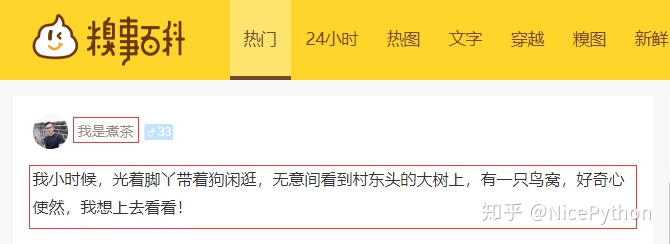Crawlspider
一:Crawlspider简介
CrawlSpider其实是Spider的一个子类,除了继承到Spider的特性和功能外,还派生除了其自己独有的更加强大的特性和功能。其中最显著的功能就是”LinkExtractors链接提取器“。Spider是所有爬虫的基类,其设计原则只是为了爬取start_url列表中网页,而从爬取到的网页中提取出的url进行继续的爬取工作使用CrawlSpider更合适。
二:CrawlSpider整体的爬取流程:
a)爬虫文件首先根据其实url,获取该url的网页内容
b)链接提取器会根据提取规则将步骤a中网页内容中的链接进行提取
c)规则解析器会根据指定解析规则将链接提取器中提取到的链接中的网页内容根据指定的规则进行解析
d)将解析数据封装到item中,然后提交给管道进行持久化存储
三:Crawlspider使用
实例:爬取https://www.qiushibaike.com/主页帖子作者以及内容

1.创建scrapy工程

2.创建爬虫文件

注意:对比以前的指令多了 "-t crawl",表示创建的爬虫文件是基于CrawlSpider这个类的,而不再是Spider这个基类。
3.生成的目录结构如下:

CrawlDemo.py爬虫文件设置:
LinkExtractor:顾名思义,链接提取器。
Rule : 规则解析器。根据链接提取器中提取到的链接,根据指定规则提取解析器链接网页中的内容。
Rule参数介绍:
参数1:指定链接提取器
参数2:指定规则解析器解析数据的规则(回调函数)
参数3:是否将链接提取器继续作用到链接提取器提取出的链接网页中,当callback为None,参数3的默认值为true。
rules=( ):指定不同规则解析器。一个Rule对象表示一种提取规则。
# -*- coding: utf-8 -*-
import scrapy
from scrapy.linkextractors import LinkExtractor
from scrapy.spiders import CrawlSpider, Rulefrom crawlPro.items import CrawlproItem
class CrawldemoSpider(CrawlSpider):name = 'crawlDemo'# allowed_domains = ['www.qiushibaike.com']start_urls = ['http://www.qiushibaike.com/']#rules元祖中存放的是不同规则解析器(封装好了某种解析规则)rules = (# Rule: 规则解析器,可以将连接提取器提取到的所有连接表示的页面进行指定规则(有中间的回调函数决定)的解析#LinkBxtractor:连接提取器,会去上面起始url响应回来的页面中,提取指定的urlRule(LinkExtractor(allow=r'/8hr/page/d+'), callback='parse_item', follow=True), #follow=True可以跟进保证将所有页面都提取出来(实际就是去重功能))def parse_item(self, response):# i = {}# #i['domain_id'] = response.xpath('//input[@id="sid"]/@value').extract()# #i['name'] = response.xpath('//div[@id="name"]').extract()# #i['description'] = response.xpath('//div[@id="description"]').extract()# return idivs=response.xpath('//div[@id="content-left"]/div')for div in divs:item=CrawlproItem()#提取糗百中段子的作者item['author'] = div.xpath('./div[@class="author clearfix"]/a[2]/h2/text()').extract_first().strip('n')# 提取糗百中段子的内容item['content'] = div.xpath('.//div[@class="content"]/span/text()').extract_first().strip('n')yield item #将item提交到管道item.py文件设置:
# -*- coding: utf-8 -*-# Define here the models for your scraped items
#
# See documentation in:
# https://doc.scrapy.org/en/latest/topics/items.htmlimport scrapyclass CrawlproItem(scrapy.Item):# define the fields for your item here like:# name = scrapy.Field()author=scrapy.Field()content=scrapy.Field()pipelines.py管道文件设置:
# -*- coding: utf-8 -*-# Define your item pipelines here
#
# Don't forget to add your pipeline to the ITEM_PIPELINES setting
# See: https://doc.scrapy.org/en/latest/topics/item-pipeline.htmlclass CrawlproPipeline(object):def __init__(self):self.fp = Nonedef open_spider(self,spider):print('开始爬虫')self.fp = open('./data.txt','w',encoding='utf-8')def process_item(self, item, spider):# 将爬虫文件提交的item写入文件进行持久化存储self.fp.write(item['author']+':'+item['content']+'n')return itemdef close_spider(self,spider):print('结束爬虫')self.fp.close()设置代理:
middlewares.py中间件:
设置代理:ip地址可以通过以下几个链接查找
http://ip.seofangfa.com/
settings.py里面设置:
DOWNLOADER_MIDDLEWARES = {'crawlPro.middlewares.Mydaili': 543, #Mydaili名字就是中间件里面的类名
}middlewares.py中间件设置:
class Mydaili(object):def process_request(self,request,spider):request.meta['proxy'] = "http://119.28.195.93:8888")
响应式创意餐饮酒店装饰设计类网站织梦模板 html5蓝色餐饮酒店设计网站源码下载...)




)





)



)


